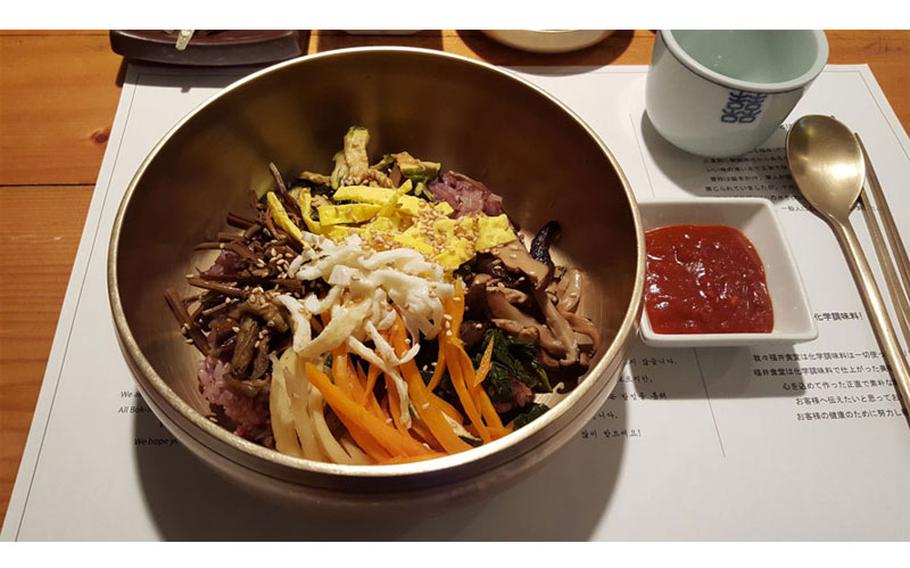Food & Drink
Let's cook up Korea's popular bibimbap!
U.S. Army July 23, 2024

()
Someone once said, "First we eat, then we do everything else." That's a quote that probably few, if any would disagree with. For people from all walks of life - regardless of their gender, race, or ethnic background, probably the next best thing to talking about food, is eating it. It's something that South Koreans find purely delightful, and is almost always a welcomed topic.
For USAG Daegu and Area IV members of the community, If there is a challenge when it comes to deciding just what Korean dish you'd like to experience, if you haven't already, then a simple, yet very traditional dish called 'Bibimbap" might be just the one to sink your teeth into.
Bibimbap (Bee-bim-bop) is one of Korea's most famous foods. Foreigners and natives alike have long enjoyed this nutritious dish of steamed rice topped with many kinds of sautéed and seasoned vegetables, beef, and fried egg. The ingredients are all mixed with Gochujang (Go-chu-chang, a seasoned red chili pepper paste) all mixed right at the table just before eating.
The term bibim means “mixed” and bap means rice, literally it means “mixed rice”. The name Bibimbap was first appeared in the Siuijeonseo, a cookbook from the late 19th century. Before the name Bibimbap was widely adopted in the early 20th century. From the Joseon Period (1392–16th century) until the 20th century, Bibimbap was called Goldongban, which means "rice made by mixing various types of food." This dish was traditionally eaten on the eve of the lunar New Year or at an ancestral rite (Jesa) by mixing all the food offerings made, in a bowl.
Just like many American foods, Bibimbap can be prepared in a number of forms. Regardless of how it's served, it continues to be an all time favorite for both the young and old. For your pleasure, the nutritious dish can be served in a hot stone bowl (dolsot). This form of preparation is often available in many Korean restaurants.
There's another plus for this healthy Korean meal, and that's its convenience. It is widely known throughout Korea that when the cook is sometimes not in the mood for preparing an all too time consuming, lavish homemade meal, Bibimbap, along with leftover side dishes, often saves the day. Bibimbap is just that versatile.
For those who haven't tried many Korean dishes, Bibimbap, made to your liking, and by your own hands is just a recipe away. It's as simple as a visit to the Camp Carroll or Camp Walker commissary or a local Korean market to obtain the necessary ingredients. From there, it's only a matter of following a recipe quite like the one in this article. To make the challenge even more fun, ask a family member and or friend to join in. The experience is certain to make your tour in Korea a memorable one.
Bibimbap Recipe -- Contributed by Ms. Jung, Yun-Kyeong Bibimbap Serving for 1 individual:
Ingredients: 5 ounces of cooked rice, 3 ounces of soybean sprouts, one small carrot, a half onion, one zucchini, 1 ounce of gosari (brake fern), 1 ounce of spinach, 2 ounces thinly sliced beef, rib eye or sirloin, one egg, 4 teaspoons minced garlic, 2 tablespoons of chopped scallion, 3 tablespoons of Gochujang (red chili pepper paste), soy sauce, sesame oil, salt, sugar, pepper, sesame seeds, and vegetable oil
Bulgogi Sauce: 1 tablespoon of soy sauce, 1 teaspoon of salt, 1 tablespoon of sesame oil, 1 teaspoon of minced garlic, 1 of tablespoon chopped scallion, 1 teaspoon of sugar…
Mix all ingredients for bulgogi sauce in a bowl. Add beef and marinate for 30 minutes. Sauté the beef in a skillet for 3-5 minutes over high heat until it’s fully cooked.
Cut the carrot into thin strips, cut the zucchini in half lengthwise, and then slice crosswise thinly, and slice the half of onion thinly. Sauté those ingredients in a skillet separately with 1 tablespoon of vegetable oil (season with a pinch of salt).
Cut gosari into 2 or 3-inch lengths. Prepare another mixture of bulgogi sauce and marinate gosari with the sauce for 15 minutes. Sauté in a skillet with 1 tablespoon of vegetable oil for 5 minutes over medium heat.
Blanch the spinach in salted boiling water just until wilted, 30 seconds. Drain, and then transfer to a bowl of ice water. Drain and squeeze out excess water. Cut into 2-inch lengths. Toss with 1 teaspoon of minced garlic, 1 teaspoon of sesame oil, and salt and pepper to taste.
Boil the bean sprouts in salted water for 3 minutes. Drain, and then transfer to a bowl of ice. Drain again, and toss with 1 teaspoon of minced garlic, 2 teaspoons of sesame oil, and salt to taste.
Place cooked rice in a bowl. Top with beef, vegetables, and a fried egg. Drizzle 2 tablespoons of sesame oil and sprinkle some sesame seeds. Serve with 3 tablespoons of Gochujang.
Happy eating!
* The vegetables in the recipe can be omitted or replaced with any vegetables in season. (Ex: sliced paprika, bok choy, lettuce, soaked and sautéed bell flower root, sliced and sautéed shiitake mushroom, etc…) Also beef can be omitted or replaced with sashimi.